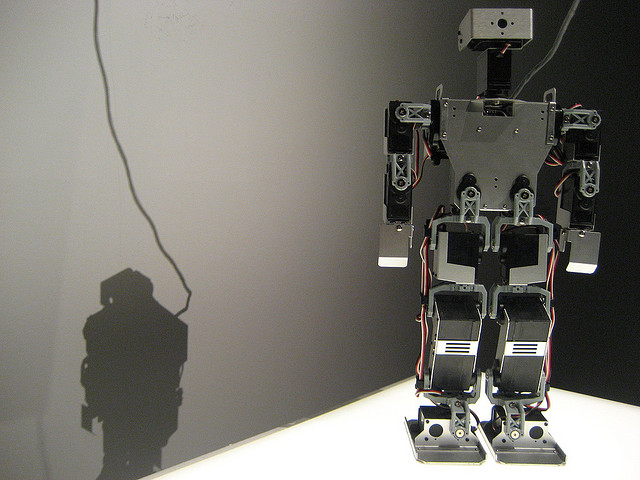How do you build a robot overlord? Piece by piece. Let’s look at how we’re doing. The last year has been a kind of watershed for “plastic pals that are fun to be with,” as Douglas Adams once called sentient androids with the brains the size of planets. In all sorts of different, but related, fields, human beings have made incredible strides at putting ourselves out of a job at the top of the food chain, cognition-wise.
A couple of weeks ago I wrote about Google Photos, a free service that allows us to store and find every photo we’ve ever taken. And, which allowed Google’s machine learning algorithm to have 2 billion pairs of eyes attached to a silicon brain that’s slurping up all that visual data like a horde of Asian bike couriers in a Tokyo noodle shop. That brain is starting to be able to tell a fruit from a vegetable, a marmot from a wombat and a tourist attraction from the wading pool in your backyard. If robot overlords were like, say, the Russians during the Cold War, we’re all part of a vast double-agent network faxing bucketloads of confidential documents to the Kremlin because, you know, free storage.
Then there’s Boston Dynamics and the DARPA Robotics Challenge. Boston Dynamics is famous for producing videos of increasingly terrifying giant industrial robots that can run, jump and leap like panthers or junkyard dogs on uppers. The company portrays them as our future military pack mules. Smart, weaponized pack mules that will, we hope, be able to tell a high-value target from, say, the wading pool in your backyard. And, if we keep kicking those metal pets around, like we do in this video, it won’t be long before we piss them off. Those things hold a grudge in long-term memory.
Meanwhile the DARPA Robotics Challenge misdirects us by showing us laugh-a-minute videos of chunky robots pratfalling, collapsing and generally acting like a bunch of Friday night frat boys who have been hit in the back of the head with a garden spade. The reality is, of course, when they’re not starring in America’s Funniest Home Robot Videos, they’re traversing uneven terrain, navigating hallways and doing a pretty good job of imitating a super strong human in a refrigerator costume.
About 400 miles away, at the Johns Hopkins Applied Physics Lab, they’re testing prosthetic limbs controlled by human thought. Researchers at CalTech are doing similar work. On the one hand, of course, this is remarkable, positive progress. Les Baugh, the subject of the Johns Hopkins research is a true cyborg, controlling mechanical limbs with brainwaves. On the other, it opens the door to the most frightening of robots — the cyborg — the machine with the human trapped inside — the Cyberman or Dalek.
And there’s Watson, IBM’s Big Blue brain that kicked ass on Jeopardy. It would be an interesting fight if Watson had a giant mind cage match with Google’s machine learning. Watson is a cognitive genius. It evaluates data like human brains. It observes, interprets, evaluates and decides. Just like us, on our good days. It’s already becoming a top-notch medical diagnostician. At Memorial Sloan Kettering Hospital, Watson is ingesting terabytes of cancer research and is being taught how Sloan Kettering oncologists treat and diagnose patients with cancer. It may be that, for Watson, cancer treatments are, well, elementary. But, that same data could be used by our robot overlords to exploit our biological weaknesses.
Speaking of which, at RealDoll, they’re working on a robotic sex doll. And, we know how that went on Battlestar Galactica.
We are, in short, building our replacements, limb by limb, picture by picture, domain by domain, genital by genital. We can now make the bodies and minds that will leave us in the dust. In many ways, that’s remarkable, wonderful even. But we really need to understand, as we look across the scope of all that humans have created in the recent past, that servant will be the master soon. Some assembly is still required. By us. For now.
Listen to an audio version of this column, read by the author, here.
Wayne MacPhail has been a print and online journalist for 25 years, and is a long-time writer for rabble.ca on technology and the Internet.
Photo: Hsing Wei/flickr



